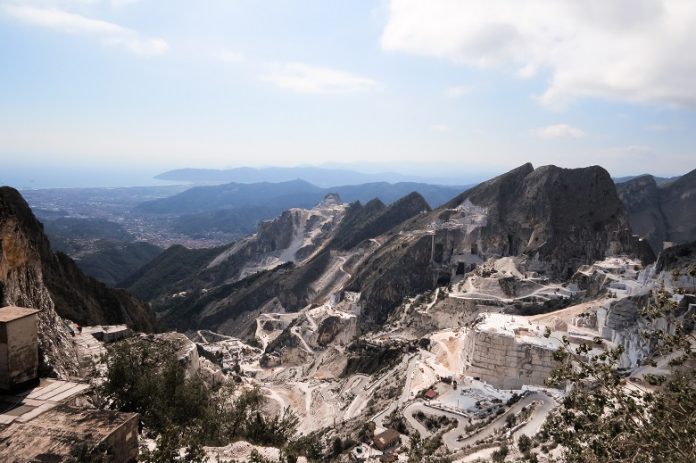Every part of the territory of the Apuan Alps is characterised by the presence of immense veins of a precious marble, which is famous all over the world and whose mining, according to historical testimonies, dates back to at least 155 BC. That is the date of creation of the first monument made of marble from Polvaccio, area close to Torano basin (which is part of the Carrione Valley together with the Miseglia and Colonnata basins).
It was a gravestone over a base dedicated to Marco Marcello, the consul who finally defeated the Liguri-Apuani people, and it was found among the ruins of Luni. Thus, it can be said that the origins of marble mining and processing dates back to the Romanisation of the Apuan area.
Pliny, in his Naturalis Historia, writes that the first who “advertised” the beauty of Apuan marble was Mamurra, Prefect of Engineers at the service of Julius Caesar. Strabo declares that after 48 BC the richest dwells of Rome and its surroundings and the main monuments were made of Luni marble: the Pantheon, the Pyramid of Cestius, the Porticus Octavia, the Temple of Apollo Palatinus, the Temple of Concord, the Arch of Claudius, the Trajan’s Forum, the Trajan’s Column, the Temple of Jupiter, the Arch of Domitian, the Bridge over the Volturno.
Carrara quarries, over different historical ages, worked mainly for foreign clients who were drawn by Luni marble. A great portion of the Italian art history owes its centuries-old fame to the marble quarried in the Apuan Alps, starting from the many Christian buildings which were embellished with architectural decorations made of marble, speaking of which, we may mention, as far as Tuscany is concerned, the Baptistery of Florence, the Cathedral of Santa Maria del Fiore and Giotto’s Campanile, Santa Croce and Santa Maria Novella churches in Florence, the Collegiata of Empoli, the Cathedral and Baptistery of Pisa, the Cathedral of Siena. Carrara itself, right after 1000 AD, started the erection of its Cathedral by blending Lombardy and Tuscany elements and decorating everything with a glorious rose window of the finest quality.
Some documents testify to the great numbers of famous sculptors and architects that came to choose statuary marbles, leaving a trace of their art in the city: for example, Nicola Pisano, who came to Carrara in 1265 to choose the marble apt to the creation of the Pulpit of Siena Cathedral, and later Michelangelo – to his stays in Carrara the guidebook dedicates a specific chapter.
Over two millennia, from the origins until today, the marble production has undergone numerous changes in each of its phases: from mining, to transportation and processing techniques. Until the 16th century, the mining methodologies remained almost unaltered (they used the separation of bench walls through fracture, practised since the Roman age), until an event that started the first true industrial revolution: in the quarries of Carrara, in 1570, the gunpowder for mines was used for the first time. An event which thrilled the marquis Alberico I Cybo-Malaspina to the point of coining a celebration coin. The separation of the block of marble from the mountain proved to be rapid and economic in that way, but it caused detrimental cracks over time and it considerably increased the quantity of waste. In the 19th century, methods based on mines were still used, but those ones involved a larger and more spectacular separation (the “varata”) which however caused detrimental effects on the environment (in addition to a great waste of material).
In 1895, the helicoidal wire was experimented and later introduced with success in almost every quarry: the shattering of the block was avoided, the quantity of waste was reduced, the squaring of blocks was made easier and the quarry was kept efficient. The diamond wire appeared in the 70s of the 20th century instead.
In addition, still at the beginning of the 20th century, the block and waste material handling techniques were modified: modern electrical hoists that permitted the handling of large blocks in a fast and safe way and carts moving on little railways instead of wooden push-cart were introduced. The installation of an important plant which spread the use of electric power in 1910 made it easier the use of the various types of motors which integrated manpower.
Nowadays, quarry technology has made great progress: tools have complemented or replaced the work of man. There are diamond single-blade gangsaws, mechanical shovels, multi-use operating machines, drilling machines: cutting-edge processing systems in the world technological innovation.
Source: www.carraramarbletour.it





































